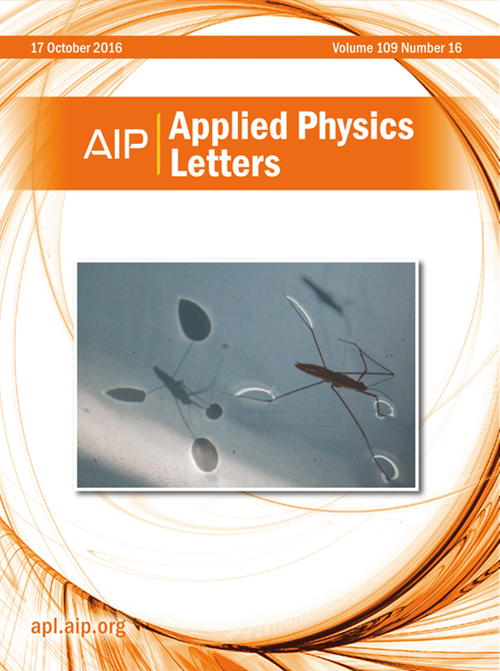InSb基底上CdTe分子束外延生长过程中铟向外扩散的抑制
IF 3.6
2区 物理与天体物理
Q2 PHYSICS, APPLIED
引用次数: 0
摘要
虽然HgCdTe仍然是高性能红外(IR)探测器的主要材料,但对成本更低、缺陷密度最小的器件的需求仍在不断增加。外延HgCdTe通常生长在低成本的Si衬底上,利用具有大晶格错配的CdTe虚拟衬底或高成本的大块CdZnTe衬底。虽然通过分子束外延可以在晶格匹配的InSb(100)和(211)B衬底上成功地生长出高质量的CdTe涂层,但由于In - out扩散和污染问题,不使用InSb衬底。本文报道了在InSb衬底上生长CdTe的不同MBE工艺的比较研究。在不同的生长条件下(富Cd和富Te),使用了一个复合CdTe细胞和两个单独的元素Cd和Te渗出细胞。与在富Te条件下使用复合CdTe细胞和Te细胞的标准CdTe生长过程相比,在富Te条件下使用单元素Cd和Te细胞在InSb上生长的CdTe涂层具有更高的质量,并且显着减少了In向外扩散。高分辨率x射线衍射FWHM线宽为35弧秒,二次离子质谱测定In浓度低于1015 cm−3,获得了高质量的CdTe脱膜。在CdTe层开始生长之前,InSb表面的重Cd浸泡也可能抑制In的向外扩散和随后的In - te合金的形成。在富Cd条件下,使用元素Cd和Te电池的CdTe涂层质量的增加在(100)和(211)方向上是一致的。本文章由计算机程序翻译,如有差异,请以英文原文为准。
Suppression of indium out-diffusion during molecular beam epitaxy growth of CdTe on InSb substrates
While HgCdTe remains the workhorse material for high-performance infrared (IR) detectors, there is still an ever-increasing demand for devices with lower costs and minimal defect densities. Epitaxial HgCdTe is typically grown on either low-cost Si substrates utilizing a CdTe virtual substrate with a large lattice mismatch or high-cost bulk CdZnTe substrates. Although high-quality CdTe epilayers can be successfully grown by molecular beam epitaxy on lattice-matched InSb (100) and (211)B substrates, InSb substrates are not used due to In out-diffusion and contamination concerns. This paper reports a comparison study of the different MBE processes of CdTe growth on InSb substrates. A compound CdTe cell and two individual elemental Cd and Te effusion cells were used under different growth conditions, Cd-rich vs Te-rich. CdTe epilayers grown on InSb under Cd-rich conditions using single elemental Cd and Te cells were shown to be of higher quality with significantly reduced In out-diffusion in regard to the standard CdTe growth process under Te-rich conditions using a compound CdTe cell and a Te cell. High-quality CdTe epilayers were achieved with a high-resolution x-ray diffraction FWHM linewidth of 35 arcsec and In concentrations below 1015 cm−3 determined from secondary ion mass spectrometry. A heavy Cd soak of the InSb surface prior to growth initiation of the CdTe layer may also suppress the out-diffusion of In and the subsequent formation of the In–Te alloy. The increase in CdTe epilayer quality under Cd-rich conditions using elemental Cd and Te cells is found to be consistent for both (100) and (211) orientations.
求助全文
通过发布文献求助,成功后即可免费获取论文全文。
去求助
来源期刊

Applied Physics Letters
物理-物理:应用
CiteScore
6.40
自引率
10.00%
发文量
1821
审稿时长
1.6 months
期刊介绍:
Applied Physics Letters (APL) features concise, up-to-date reports on significant new findings in applied physics. Emphasizing rapid dissemination of key data and new physical insights, APL offers prompt publication of new experimental and theoretical papers reporting applications of physics phenomena to all branches of science, engineering, and modern technology.
In addition to regular articles, the journal also publishes invited Fast Track, Perspectives, and in-depth Editorials which report on cutting-edge areas in applied physics.
APL Perspectives are forward-looking invited letters which highlight recent developments or discoveries. Emphasis is placed on very recent developments, potentially disruptive technologies, open questions and possible solutions. They also include a mini-roadmap detailing where the community should direct efforts in order for the phenomena to be viable for application and the challenges associated with meeting that performance threshold. Perspectives are characterized by personal viewpoints and opinions of recognized experts in the field.
Fast Track articles are invited original research articles that report results that are particularly novel and important or provide a significant advancement in an emerging field. Because of the urgency and scientific importance of the work, the peer review process is accelerated. If, during the review process, it becomes apparent that the paper does not meet the Fast Track criterion, it is returned to a normal track.
 求助内容:
求助内容: 应助结果提醒方式:
应助结果提醒方式:


